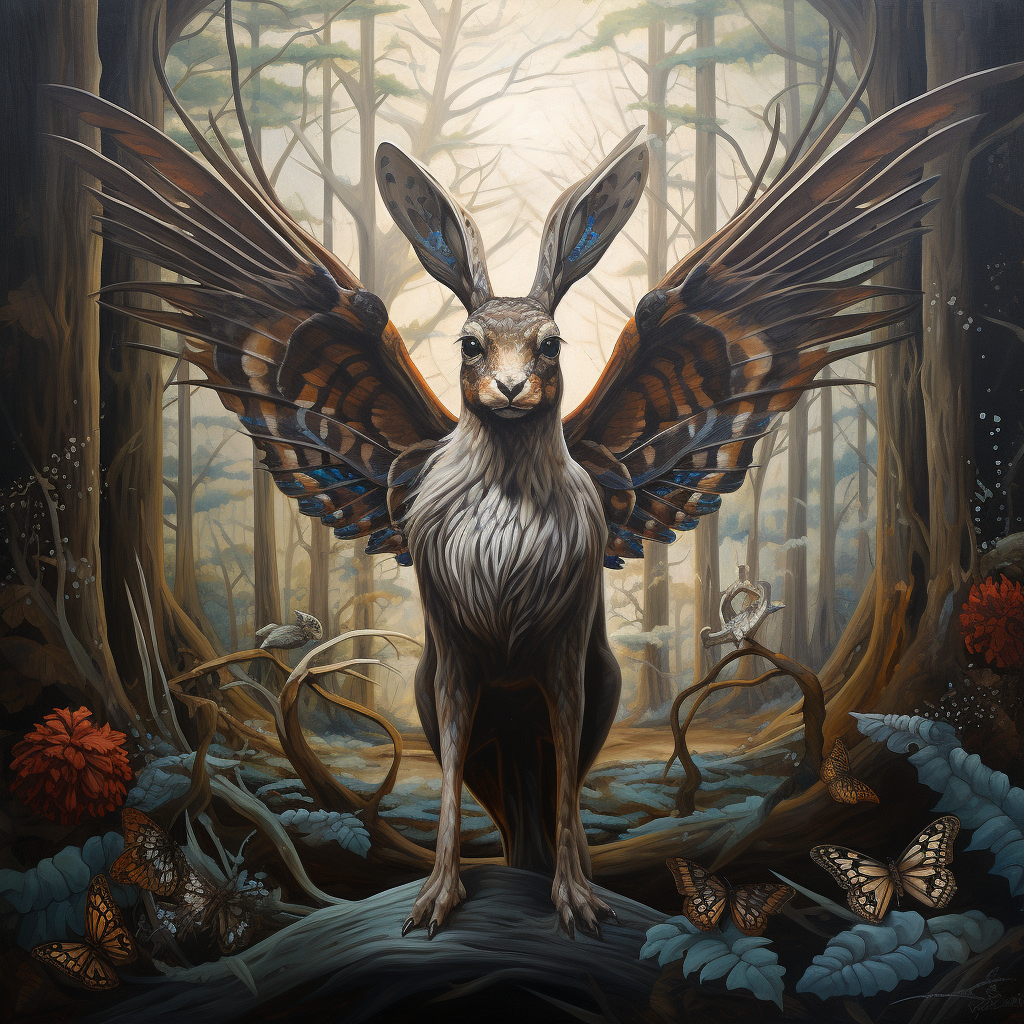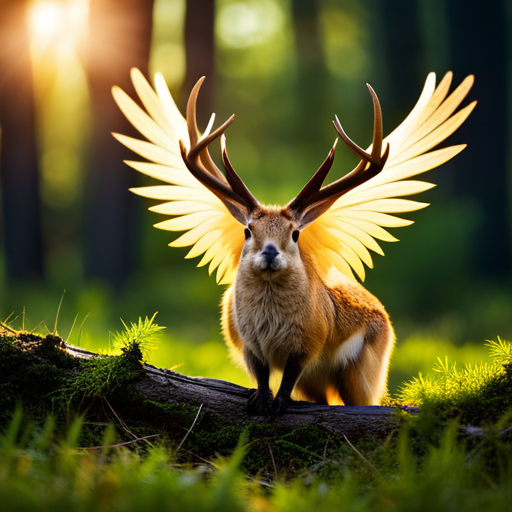In Bavarian folklore, the Wolpertinger is a mythical creature that has captured the imagination of many with its bizarre appearance. This chimeric animal is often described as a mash-up of various creatures such as a rabbit, squirrel, deer, and pheasant. Its weird combination of features makes it a fascinating subject for those interested in supernatural and legendary beings.
The Wolpertinger is said to inhabit the alpine forests of Bavaria and Baden-Württemberg in southern Germany, lurking in the shadows and captivating the minds of those who hear about it. Originating from an unclear source, this creature transcends cultural boundaries and has generated various counterparts in different countries. With a rich history rooted in German folklore, the Wolpertinger continues to be an enigmatic creature that sparks curiosity and wonder.
Surprisingly, much of Wolpertinger’s fame can be attributed to the playful antics of Bavarian taxidermists in the 1800s. These creative individuals began assembling the body parts of various animals to create Wolpertinger hybrids, which they then sold to unsuspecting buyers. Despite its fabricated origins, the Wolpertinger has cemented itself as a significant part of German folklore and remains a popular topic among enthusiasts of mythical creatures.
Wolpertinger Origins and Folklore
Bavarian Mythology
The Wolpertinger, a mythical creature from German folklore, is said to inhabit the Alpine forests of Bavaria and Baden-Württemberg in southern Germany. The creature is believed to emerge during a full moon or on Walpurgisnacht, a traditional spring holiday celebrated on the night of April 30th.
This outlandish mix of various woodland creatures, such as a hare, a duck, a fox, and a pine marten, often comes alive in the Bavarian Alps, thanks to the mischievous work of Bavarian taxidermists in the early 1800s. These taxidermists began creating Wolpertingers by combining parts of different animals, and the resulting hybrids were sold to gullible tourists as souvenirs.
The tales of these woodland creatures are not limited to the Bavarian forests. In Sweden, a similar creature known as the Raurakl has captured the imagination of the local people. North American folklore features the Jackalope, an antlered rabbit, which is another counterpart of the Wolpertinger.
Cultural Variants
In addition to the Wolpertinger, other related creatures from German culture share some similar traits. One of these is the Elwedritsche, a bird-like mythical creature said to inhabit the woods of southern Germany and the Alps. These creatures are known for their strange appearance and outlandish behavior.
Bavarian folklore and its mythical inhabitants have been passed down through generations via fairy tales, fables, and books, captivating the minds of young and old alike. As folklore creatures, Wolpertingers and their counterparts are important symbols of German culture and traditions.
Whether for fun or to genuinely share their beliefs, Bavarians continue to tell the stories of the Wolpertinger and its mythical cousins, perpetuating their significance in German folklore. These fabulous creatures provide a sense of mystery and imagination, giving woodlands an otherworldly feeling during moonlit nights, while serving as a reminder of the rich cultural heritage of Bavaria and southern Germany.
Physical Description and Attributes
Anatomical Characteristics
The Wolpertinger is a mythical creature often described as a hybrid of various animals such as a rabbit, squirrel, deer, and pheasant. Its body is usually said to resemble that of a hare or a squirrel, with thick fur covering its body. Having the head of a rabbit, the Wolpertinger also features fangs, giving it a slightly menacing appearance. Its feet are similar to those of a mammal, particularly those of rabbits and hares.
Unique Features
One of the most striking features of the Wolpertinger is its unusual antlers or horns, which usually resemble those of a deer. This horned rabbit-like creature stands out among other mythical creatures due to its unique combination of anatomical characteristics.
Another fascinating aspect of the Wolpertinger is its wings, which are typically reminiscent of a bird, usually a pheasant or duck. These wings not only contribute to the creature’s unique and mythical appearance but also allow it to maneuver through the air with agility.
Some of the other characteristics attributed to the Wolpertinger include:
- Beaks: In some descriptions, the Wolpertinger has been said to possess a beak akin to a bird instead of a rabbit-like head.
- Fangs: As previously mentioned, the creature has been said to have fangs, adding to its uncommon appearance.
- Thick tufts of hair: The mammalian feet of the Wolpertinger usually feature tufts of hair, which only adds to its oddity.
The Wolpertinger is known under various names, such as “woiperdinger,” “walpertinger,” or “wulpertinger,” and serves as an interesting example of local wildlife in southern German folklore. This mythical creature is not the only one of its kind, with other similar hybrids like the jackalope, rasselbock, and skvader also capturing the imagination of people across different cultures.
Role in Popular Culture

Hunting and Collecting Wolpertingers
In Bavarian folklore, Wolpertingers are elusive creatures, often hunted or collected as trophies. Traditionally, hunters embark on a journey to search for and catch the mythical beasts, armed with a few tools: a bag of salt, a candle, and a pair of pincers. According to local stories, the salt is used to attract Wolpertingers, as they are believed to be attracted to the substance. Once a Wolpertinger is within reach, the pincers are used to pluck tufts of hair from the creature, as they are said to have magical properties. Hunters must be cautious, though, as these elusive creatures are said to be as cunning as foxes and as agile as ducks.
Interest in hunting and collecting Wolpertingers can also be seen in pubs and restaurants throughout Bavaria, as they often feature stuffed Wolpertingers on display for customers to admire. Not only do these establishments boast their extensive collection of the fabled creatures, but they also further the lore and add to the mystique of these creatures.
Museum Exhibits
The German Hunting and Fishing Museum in Munich is home to an exquisite collection of stuffed Wolpertingers. These creatures have been skillfully crafted by taxidermists, making them popular attractions for both tourists and locals. The museum preserves these fascinating animals, spreading the myth and intrigue surrounding Wolpertingers from generation to generation.
Wolpertinger in Art
Wolpertingers have also left their mark in the realm of art. Artists often integrate Wolpertingers into their work, knowing that the mysterious creatures capture the imagination and interest of their audience. For instance, Albrecht Dürer’s painting “Young Hare” is sometimes said to have been inspired by one of these peculiar animals. Moreover, in Zurich, a famous establishment known as the Rheinfelder Beerhall showcases a stuffed Wolpertinger on display, which has become a curiosity for visitors.
The intertwined art and lore surrounding Wolpertingers have shaped aspects of popular culture. From hunting expeditions to museum exhibits and artistic endeavors, these creatures have played a unique role in capturing the curiosity and fascination of Bavarian culture.
Natural History and Ecology

Habitat
The Wolpertinger, a mythical creature often depicted as a mix of rabbit, squirrel, deer, and pheasant, is said to inhabit the alpine forests of Bavaria and Baden-Württemberg in southern Germany1. Its unusual appearance, which is said to be the result of a hare and deer mating, catches the attention of many who are interested in folklore. These creatures can usually be found in areas rich in herbs and roots, which they use to maintain their sustenance.
Feeding Habits
The diet of a Wolpertinger predominantly consists of roots and herbs found in their natural habitat. It is said that the creature’s saliva holds a peculiar property that helps it digest these roots and herbs efficiently. The diverse diet allows the Wolpertinger to thrive in the alpine forests, despite its bizarre appearance and the many dangers it faces from hunters.
Breeding
The Wolpertinger has a rather unique and mysterious breeding process. Legend says that a single woman finds the Wolpertinger attractive due to some sort of mystifying quality they possess. This is what leads to the possibility of a romantic relationship between the mythological creature and a human female. This unique inter-species connection eventually results in the birth of mutant offspring, further diversifying the Wolpertinger family5.
Relationships
Wolpertingers, despite their bizarre appearance and curious breeding habits, have managed to find a place in Bavarian culture. Hunters, in particular, are quite interested in the Wolpertinger, seeing them as trophies to add to their collections. As such, the creatures are often hunted in the forests where they reside, making their existence all the more mysterious and elusive.
Traditional hotels and other cultural establishments in Bavaria also keep stuffed Wolpertingers on display as symbols of local folklore. Their intriguing history, combined with the legend surrounding their existence, makes them a fascinating topic of conversation among both locals and tourists alike.
Conclusion
In summary, the Wolpertinger is a fascinating mythical creature from Bavarian folklore, often depicted as a hybrid animal that includes elements of a rabbit, squirrel, deer, and pheasant. Its origins remain unclear, but it’s believed that Bavarian taxidermists in the 1800s popularized the legend by crafting and selling Wolpertinger hybrids made from various animal parts.
Despite its potentially frightening appearance, learning about the Wolpertinger can provide a unique insight into German cultural history and its diverse heritage. Throughout time, various stories have developed around this creature, and it has transcended its initial role within Bavarian folklore to become an interesting part of intercultural dialogue.
So, while the Wolpertinger might not be the most famous of legendary creatures, it is certainly an unconventional and captivating aspect of German folklore. The creature’s various forms and the stories that surround it will likely continue to intrigue people for generations to come.

